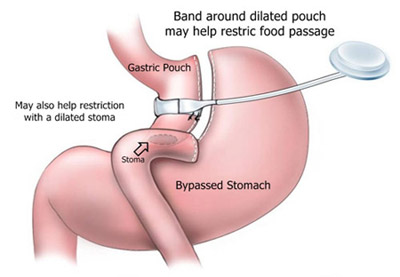Lap-Band after Gastric Bypass

Review of the Roux-n-Y Procedure
In Roux-n-Y bariatric surgery, the surgeon makes your stomach smaller by creating a small pouch of about 1 to 2 ounces. The surgeon sews the top of your small intestine to the small pouch, thereby bypassing the remainder of your original stomach pouch. When combined with lifestyle changes, a successful surgery can help you lose 60 to 70 percent of your original body weight within 5 to 15 years. However, 15 percent of Roux-n-Y procedures are not considered successful because patients do not end up losing the amount of weight they had hoped for.
How Does a Lap Band after Gastric Bypass Work?
A laparoscopic band, or Lap Band, is a possibility for Roux-n-Y patients who have seen their weight loss slow or even reverse. A Band over Bypass, or BOB, describes the process of putting in an adjustable band in patients who have had Roux-n-Y patients. The surgeon needs to make only small incisions in the wall of your abdomen in order to insert the inflatable band. The band restricts your stomach size by cutting off the lower part of the stomach so that the upper pouch is smaller. Similar to Roux-n-Y, this helps you feel full faster. A BOB is minimally invasive and does not require changes to the work done in the earlier Roux-n-Y procedure.
Why It Works
A Roux-n-Y procedure is good for rapid results, but some patients need a little more help to maintain their weight loss. Modifications in your diet and exercise routines are crucial for long-term success in controlling your weight, and the Lap Band helps you focus on these lifestyle changes. Years after the early effects of a Roux-n-Y surgery have worn off, the BOB procedure can safely get you back on track to following the diet and exercise program that can keep up your weight loss and improve your health.
Band over Bypass in the News: Carnie Wilson
Television host and singer Carnie Wilson, age 44, is a recent example of a patient who had a Lap Band after gastric bypass. Wilson had struggled with her weight for years, and had tried many diets without long-term success. In 1999, weighing nearly 300 pounds, Wilson underwent Roux-n-Y surgery in an effort to improve her health and save her career. She lost 150 pounds, but eventually returned to yo-yo dieting. In January of 2012, she had Lap Band put in. Wilson hopes that her Band over Bypass procedure will be her permanent solution to good health and control of her weight. The Weight Loss Surgery Foundation of America supports her decision to rededicate herself to a healthy lifestyle.
Making the Decision
If you’re a Roux-n-Y patient whose weight loss has stalled or been reversed, you might be a good candidate for a BOB. The lap band is an outpatient procedure that takes only about 40 minutes. A study published in the journal Surgery for Obesity and Related Diseases found very few complications and an average weight loss of 47 percent of excess weight at the five-year mark. After following a very rigid post-op diet for about five weeks, you’ll be ready for your new, lifetime program. Your plan will include three small meals per day, nutritious foods, 30 minutes of exercise most days of the week and plenty of water.

